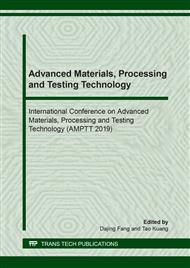[1]
G.L. Bennett, R.J. Hemler, A. Schock, Space nuclear power-An overview, Journal of Propulsion and Power 12 (1996) 901-910.
DOI: 10.2514/3.24121
Google Scholar
[2]
V.P. Kobyakov, Promising variants of single crystal tungsten electrodes for high-performance thermionic converters, Technical Physics 47 (2002) 1310-1315.
DOI: 10.1134/1.1514813
Google Scholar
[3]
H.T. Huang, J.P. Zheng, Y.F. Wei, S.J. Chen, Z.D. Wang, C.W. Tan, Microstructure Evolution of Single Crystal Tungsten Serving Under High Temperature for Long Time, Atomic Energy Science and Technology 48 (2014) 528-534.
Google Scholar
[4]
B.H. Tsao, M.L. Ramalingam, B.D. Donovan, J.S. Cloyd, Thermionic energy conversion with a preferentially oriented tungsten emitter, American Institute of Physics 217 (1991) 787-792.
DOI: 10.1063/1.40089
Google Scholar
[5]
L. Yang, R.G. Hudson, Evaluation Of Chemically Vapor Deposited Tungsten As Electron Emitters For Nuclear Thermionic Application, (1968).
Google Scholar
[6]
Ira. Weissman, M.L. Kinter, Improved Thermionic Emitter Using Uniaxially Oriented Tungsten, Journal of Applied Physics 34 (1963) 3187-3194.
DOI: 10.1063/1.1729161
Google Scholar
[7]
Yu.V. Nikolaev, Nuclear Power Engineering in Space, 1993, p.5.
Google Scholar
[8]
V.S. Emel'yanov, A.I. Evstyukhin, V.A. Shulov, Theory of Production Processes of Pure Metals, Alloys, and Intermetallides, Énergoatomizdat, Moscow (1983).
Google Scholar
[9]
V.P. Kobyakov, Vysokochist, Veshchestva, 45 (1994) 6.
Google Scholar
[10]
V.P. Smirnov, Yu.I. Sidorov, V.P. Janchur, Epitaxial Deposition Mononcrystal Tungsten Using Chmeical Transport Recation, Surface Physics Chemistry Mechanics 4 (1986)123–128.
Google Scholar
[11]
V.P. Smirnov, D.S. Kiselev, Preparation of high-purity single-crystal W and W〈Nb〉 via chemical vapor transport, Inorganic Materials 48 (2012) 1093-1095.
DOI: 10.1134/s0020168512110131
Google Scholar
[12]
Y.W. Lv, X.D. Yu, C.W. Tan, H.L. Ma, J.P. Zheng, F.C. Wang, H.N. Cai, Deposition temperature effects on tungsten single-crystal layer by chemical vapor transport, Journal of Crystal Growth 329 (2011) 62-66.
DOI: 10.1016/j.jcrysgro.2011.06.040
Google Scholar
[13]
Y. Lv, X. Yu, F. Wang, C. Tan, Q. Yang, J. Zheng, Z. Wang, H. Cai, Vapor phase epitaxy of monocrystal tungsten coatings, Journal of Crystal Growth 387 (2014) 111-116.
DOI: 10.1016/j.jcrysgro.2013.11.004
Google Scholar
[14]
R. Mu, C. Tan, X. Yu, Proportion quantitative analysis and etching of (110) planes on tungsten single crystal coating surface, Journal of Alloys & Compounds 666 (2016) 71-76.
DOI: 10.1016/j.jallcom.2016.01.129
Google Scholar
[15]
P. Batzies, P. Schroder-Bado, G. Wahl, BBC-Nachr, 31 (1972) 1-2.
Google Scholar
[16]
L. Yang, R.G. Hudson, H. Johnson, et al., in Proceedings of the 3rd International Conference on Thermionic Electrical Power Generation, Julich, (1972) 32.
Google Scholar
[17]
W.A. Bryant, Review the fundamentals of chemical vapour deposition, Journal of materials science 12 (1977) 1285-1306.
Google Scholar
[18]
R. Arora, P. Pollard, Application to low-pressure deposition of tungsten, Journal of the Electrochemical Society 138 (1991) 1523.
Google Scholar
[19]
C.R. Kleijn, C. Werner, Modeling of Chemical Vapor Deposition of Tungsten Films, Progress in Numerical Simulation for Microelectronics 84 (1993) 121-123.
Google Scholar
[20]
K.J. Kuijlaars, C.R. Kleijn, H.E.A.V.D. Akker, A detailed model for low-pressure CVD of tungsten, Thin Solid Films 270(1–2) (1995) 456-461.
DOI: 10.1016/0040-6090(96)80077-0
Google Scholar
[21]
W.A. Bryant, Kinetics of Tungsten Deposition by the Reaction of WF6 and Hydrogen, Journal of the Electrochemical Society 125(9) (1978).
Google Scholar
[22]
J. Du, Z. Li, G. Liu, Z. Hui, C. Huang, Surface characterization of CVD tungsten coating on molybdenum substrate, Surface & Coatings Technology 198 (2005) 169-172.
DOI: 10.1016/j.surfcoat.2004.10.130
Google Scholar
[23]
K.K. Lai, H.H. Lamb, Tungsten chemical vapor deposition using tungsten hexacarbonyl: microstructure of as-deposited and annealed films, Thin Solid Films 370 (2000) 114-121.
DOI: 10.1016/s0040-6090(00)00943-3
Google Scholar
[24]
D.C. Mancini, P. Skytt, J. Nordgren, P. Tägtström, Chemical vapour deposition of Cr, Mo and W thin films induced by synchrotron radiation, Vacuum 46 (1995) 1165-1169.
DOI: 10.1016/0042-207x(95)00132-8
Google Scholar
[25]
X.N. Ren, H. Zhou, C.C. Ge, X.Q. Liu, Y. Li, W.P. Zhou, W.L. Liu, Z.J. Zhou, X.G. Zhang, M. Xia, Proposal and research on using tungsten carbonyl-CVD process for making W-coating PFMs and W-tubes, Journal of Nuclear Materials 455 (2014) 582-585.
DOI: 10.1016/j.jnucmat.2014.08.049
Google Scholar
[26]
J.Q. Shi, S.Y. Yao, F. Wang, X.D. Yu, H.T. Huang, C.W. Tan, Z.H. Nie, H.L. Ma, H.N. Cai, Microstructures of chemical vapor deposited high-purity tungsten achieved by two different precursors, Materials Characterization 134 (2017) 1-8.
DOI: 10.1016/j.matchar.2017.10.007
Google Scholar
[27]
H.B. Michaelson, The work function of the elements and its periodicity, Journal of Applied Physics 48 (1977) 4729-4733.
DOI: 10.1063/1.323539
Google Scholar
[28]
H.B. Michaelson, Relation Between an Atomic Electronegativity Scale and the Work Function, Ibm Journal of Research & Development 22 (1978) 72-80.
DOI: 10.1147/rd.221.0072
Google Scholar
[29]
E.W. Muller, Work Function of Tungsten Single Crystal Planes Measured by the Field Emission Microscope, Journal of Applied Physics 26 (1955) 732-737.
DOI: 10.1063/1.1722081
Google Scholar


